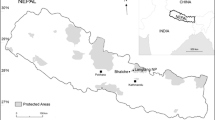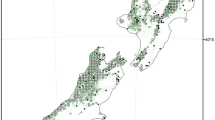Abstract
This study utilizes remote sensing derived forest aboveground biomass (AGB) estimates and ownership information obtained from the Protected Areas Database (PAD), combining landscape analyses and GIS techniques to demonstrate how different ownerships (public, regulated private, and other private) relate to the spatial distribution of AGB in New England states of the USA. “Regulated private” lands were dominated by lands in Maine covered by a Land Use Regulatory Commission. The AGB means between all pairs of the identified ownership categories were significantly different (P < 0.05). Mean AGB observed in public lands (156 Mg/ha) was 43% higher than that in regulated private lands (109 Mg/ha), or 30% higher than that of private lands as a whole. Seventy-seven percent of the regional forests (or about 9,300 km2) with AGB >200 Mg/ha were located outside the area designated in the PAD and concentrated in western MA, southern VT, southwestern NH, and northwestern CT. While relatively unfragmented and high-AGB forests (>200 Mg/ha) accounted for about 8% of total forested land, they were unevenly proportioned among the three major ownership groups across the region: 19.6% of the public land, 0.8% of the regulated private land, and 11.0% of the other private land. Mean disturbance rates (in absolute value) between 1992 and 2001 were 16, 66, and 19 percent, respectively, on public, regulated private, and other private land. This indicates that management practices from different ownerships have a strong impact on dynamic changes of landscape structures and AGB distributions. Our results may provide insight information for policy makers on issues regarding forest carbon management, conservation biology, and biodiversity studies at regional level.




Similar content being viewed by others
Notes
A new version of PAD (although numbered version 1) was released as this manuscript was through the review process.
References
ESRI ArcGIS 9.2 Desktop Help (2008) http://webhelp.esri.com/arcgisdesktop/9.2/index.cfm?TopicName=BlockMajority. Accessed 3 Jan 2008
Anderson JR, Hardy EE, Roach JT, Witmer WE (1976) A land use and land cover classification system for use with remote sensing data. US geological survey professional paper 964, Reston, VA, 28 p
Askins RA, Philbrick MJ, Sugeno DS (1987) Relationship between the regional abundance of forest and the compostition of forest bird communities. Biological Conservation 39:129–152
Butler BJ (2008) Family forest Owners of the United States, 2006. Gen Tech Rep NRS-27. US Department of Agriculture, Forest Service, Northern Research Station, Newtown Square, PA, 72 p
Buyantuyev A, Wu J (2007) Effects of thematic resolution on landscape pattern analysis. Landscape Ecology 22:7–13
Chhetri DBK (1999) Comparison of forest biomass across a human-induced disturbance gradient in Nepal’s Schima-Castanopsis forests. Journal of Sustainable Forestry 9:69–82
Cleary DFR, Genner MJ, Boyle TJB, Setyawati T, Angraeti CD, Menken SBJ (2005) Associations of bird species richness and community composition with local and landscape-scale environmental factors in Borneo. Landscape Ecology 20:989–1001
DellaSala DA, Staus NL, Strittholt JR, Hackman A, Iacobelli A (2001) An updated protected areas database for the United States and Canada. Natural Areas Journal 21:124–135
Egan AF (2007) Farm woodlots in northern New England, USA: Characteristics, management, and contributions to the whole farm system. Renewable Agriculture and Food Systems 22:67–73
Franklin J, Hiernaux PHY (1991) Estimating foliage and woody biomass in Sahelian and Sudanian woodlands using a remote sensing model. International Journal of Remote Sensing 12:1387–1404
Heilman GE Jr, Strittholt JR, Slosser NC, Dellasala DA (2002) Forest fragmentation of the conterminous United States: Assessing forest intactness through road density and spatial characteristics. BioScience 52:411–422
Hollister JW, Gonzalez ML, Paul JF, August PV, Copeland JL (2004) Assessing the accuracy of National Land Cover Dataset area estimates at multiple spatial extents. Photogrammetric Engineering and Remote Sensing 70:405–414
Homer C, Huang C, Yang L, Wylie B, Coan M (2004) Development of a 2001 National Land-cover Database for the United States. Photogrammetric Engineering and Remote Sensing 70:829–840
Houghton RA (2005) Aboveground forest biomass and the global carbon balance. Global Chang Biology 11:945–958
Irland LC (1999) The Northeast’s changing forest. Harvard University Press, Cambridge, Massachusetts 401 pp
Johnson CM, Zarin DJ, Johnson AH (2000) Post-disturbance aboveground biomass accumulation in global secondary forests. Ecology 81:1395–1401
Jones SB, Luloff AE, Finley JC (1995) Another look at NIPFs: Facing our ‘myths’. Journal of Forestry 93:41–44
Khera N, Kumar A, Ram J, Tewari A (2001) Plant biodiversity assessment in relation to disturbances in mid-elevational forest of Central Himalaya, India. Tropical Ecology 42:83–95
Knight AT, Cowling RM, Rouget M, Balmford A, Lombard AT, Campbell BM (2008) Knowing but not doing: selecting priority conservation areas and the research-implementation gap. Conservation Biology 22:610–617
Lefsky MA, Cohen WB, Harding DJ, Parker GG, Acker SA, Gower ST (2002) Lidar remote sensing of above-ground biomass in three biomes. Global Ecology and Biogeography 11:393–399
Lu D (2005) Aboveground biomass estimation using Landsat TM data in the Brazilian Amazon. International Journal of Remote Sensing 26:2509–2525
Ma Z-K (1995) Using a rule-based merging algorithm to eliminate ‘salt/pepper’ and small regions of classified image. In: Ninth annual symposium on geographic information systems, Vancouver, British Columbia, Canada, pp 834–837
Maine (2009) Land use regulation commission. http://www.maine.gov/doc/lurc/
Muukkonen P, Heiskanen J (2007) Biomass estimation over a large area based on standwise forest inventory data and ASTER and MODIS satellite data: A possibility to verify carbon inventories. Remote Sensing of Environment 107:617–624
Nelson R, Krabill W, Tonelli J (1988) Estimating forest biomass and volume using airbone laser data. Remote sensing of environment 24:247–267
Richards WH, Wallin DO, Schumaker NH (2002) An analysis of late-seral Forest connectivity in Western Oregon. U.S.A. Conservation Biology 16:1409–1421
Ryu S-R, Chen J, Zheng D, Bresee MK, Crow TR (2006) Simulating the effects of prescribed burning on fuel loading and timber production in managed northern Wisconsin forests. Ecological Modeling 196:395–406
Sachs DL, Sollins P, Cohen WB (1998) Detecting landscape changes in the interior of British Columbia from 1975 to 1992 using satellite imagery. Canadian Journal of Forest Research 28:23–36
Smith JE, Heath LS (2007) Forest carbon sequestration and products storage. The US agriculture and forestry greenhouse gas inventory: 1990–2006. In: USDA, Office of the Chief Economist, Global Change Program Office, Washington DC
Spies TA, Ripple WC, Bradshaw GA (1994) Dynamics and pattern of a managed coniferous forest landscape in Oregon. Ecological Applications 4:555–568
Stehman SV, Wickham JD (2006) Assessing accuracy of net change derived from land cover maps. Photogrammetric Engineering and Remote Sensing 72:175–185
Stehman SV, Wickham JD, Smith JH, Yang L (2003) Thematic accuracy of the 1992 National Land-Cover Data for the eastern United States: Statistical methodology and regional results. Remote Sensing of Environment 86:500–516
Turner MG, Wear DN, Flamm RO (1996) Land ownership and land cover change in the Southern Appalachian highlands and Olympic peninsula. Ecological Applications 6:1150–1172
Vogelmann JE, Howard SM, Yang L, Larson CR, Wylie BK, Van Driel N (2001) Completion of the 1990s National Land Cover Dataset for the conterminous United States from Landsat Thematic Mapper data and ancillary data sources. Photogrammetric Engineering and Remote Sensing 67:650–652
Wallace GN, Theobald DM, Ernst T, King K (2008) Assessing the ecological and social benefits of private land conservation in Colorado. Conservation Biology 22:284–296
Waring RH, Running SW (1998) Forest ecosystems: analysis at multiple scales. Academic Press, San Diego
Wickham JD, Stehman SV, Smith JH, Yang L (2004) Thematic accuracy of the 1992 National Land-Cover Data for the western United States. Remote Sensing of Environment 91:452–468
Wu J (1999) Hierarchy and scaling: extrapolating information along a scaling ladder. Canadian Journal of Remote Sensing 25:367–380
Zheng D, Wallin DO, Hao Z (1997) Rates and patterns of landscape change between 1972 and 1988 in the Changbai Mountain area of China and North Korea. Landscape Ecology 12:241–254
Zheng D, Rademacher J, Chen J, Crow T, Bresee M, LeMoine J, Ryu S-R (2004) Estimating aboveground biomass using Landsat 7 ETM + data across a managed landscape in northern Wisconsin, USA. Remote Sensing of Environment 93:402–411
Zheng D, Heath LS, Ducey MJ (2007) Forest biomass estimated from MODIS and FIA data in the Lake States: MN, WI, and MI, USA. Forestry 80:265–278
Zheng D, Heath L, Ducey M (2008a) Satellite detection of land-use change and effects on regional forest aboveground biomass estimates. Environmental Monitoring and Assessment 144:67–79
Zheng D, Heath LS, Ducey MJ (2008b) Spatial distribution of forest aboveground biomass estimated from remote sensing and forest inventory data in New England, USA. Journal of Applied Remote Sensing 2:021502
Acknowledgments
This study is supported by the USDA Forest Service, Northern Research Station through grant 05-DG-11242343-074.
Author information
Authors and Affiliations
Corresponding author
Rights and permissions
About this article
Cite this article
Zheng, D., Heath, L.S., Ducey, M.J. et al. Relationships Between Major Ownerships, Forest Aboveground Biomass Distributions, and Landscape Dynamics in the New England Region of USA. Environmental Management 45, 377–386 (2010). https://doi.org/10.1007/s00267-009-9408-3
Received:
Accepted:
Published:
Issue Date:
DOI: https://doi.org/10.1007/s00267-009-9408-3




